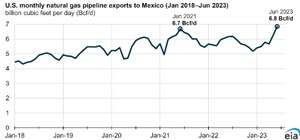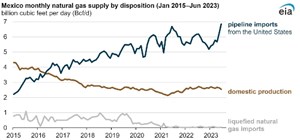U.S. natural gas pipeline exports to Mexico set a monthly high in June 2023
U.S. natural gas pipeline exports to Mexico averaged a record 6.8 billion cubic feet per day (Bcf/d) for June 2023, which is 0.1 Bcf/d greater than the previous record set in June 2021, according to data from Wood Mackenzie. Natural gas exports to Mexico surpassed 7.0 Bcf/d on nine days in June, driven by higher-than-normal temperatures that increased demand for natural gas in Mexico’s electric power sector. U.S. natural gas pipeline exports to Mexico generally peak in the summer due to increased demand for electricity to power air conditioning. Mexico’s electric power sector consumption has grown by an average of 3% every year since 2018, according to data from Wood Mackenzie.
U.S. natural gas pipeline exports to Mexico averaged 5.9 Bcf/d in the first half of 2023, similar to the record-high average of 6.0 Bcf/d in the first half of 2021. After declining in 2022, U.S. natural gas pipeline exports to Mexico have returned to the highs of 2021.
In 2022, Mexico increased its domestic natural gas production by 14%, or 0.3 Bcf/d, reducing natural gas pipeline imports from the United States. In the first half of 2023, Mexico’s domestic production did not increase from 2022, but demand did. To make up the difference, pipeline imports from the United States increased 3%, or 0.2 Bcf/d.
U.S. natural gas pipeline exports to Mexico have grown in recent years as the domestic pipeline network within Mexico continues to expand:
- In 2020, the Wahalajara system, a group of pipelines that connects the Waha hub in West Texas to Guadalajara and other population centers in west-central Mexico, was completed. The Villa de Reyes–Aguascalientes–Guadalajara pipeline system (0.9 Bcf/d capacity), which connects to several other pipelines in Central Mexico, was placed in service that year. The Sierrita pipeline, which transports natural gas from Arizona to the Mexican border, was expanded by 0.3 Bcf/d.
- In 2021, the Mier-Monterrey pipeline (0.2 Bcf/d) was expanded. This pipeline delivers natural gas from U.S. connecting pipeline NET Mexico in South Texas to the Monterrey Hub in northeastern Mexico. The Samalayuca-Sásabe pipeline (0.5 Bcf/d capacity), which transports natural gas from the Permian Basin in West Texas and eastern New Mexico to northwestern Mexico, entered service.
- In 2022, two more pipelines that deliver natural gas to Mexico’s capital city region went into partial service: the Tula–Villa de Reyes pipeline (0.9 Bcf/d) is expected to begin full service in 2023, and the Tuxpan–Tula pipeline (0.9 Bcf/d) is expected to begin full service in 2025.
- In 2023, the Cuxtal Phase II pipeline—the second segment of the Energía Mayakan pipeline—is expected to enter service. The Energía Mayakan pipeline expands the natural gas pipeline network on the Yucatán Peninsula.
Related News
Related News

- ExxonMobil halts 1-Bft3d blue hydrogen project in Texas
- Aramco and Yokogawa commission multiple autonomous control AI agents at Fadhili gas plant
- Ukraine will resume gas imports via Transbalkan route in November
- Mitsubishi to inject $260 MM into Brunei LNG project
- Freeport LNG (U.S.) on track to take in more natgas on Thursday after unit outage






Comments